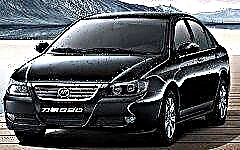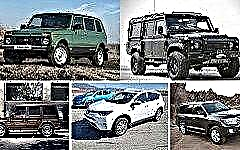

The content of the article:
- Predecessors and progenitors
- Legendary "Jeep"
- Willуs SUVs
- Domestic GAZ
- Land Rover
- Jeep Rival
- Seventies
- End of the twentieth century
- Modern SUVs
In the modern automotive industry, every well-known automaker has at least two or three types of SUVs in its model line. The demand for cars of this type is growing steadily.
However, this was not always the case: SUV had a long way to go before it reached the heights of popularity and consumer demand... Looking into the past, you can trace the development of SUVs and understand in what ways the design idea developed.
Predecessors and progenitors

An off-road vehicle is an all-wheel drive model of a passenger car that has increased cross-country ability. Four driving wheels allow such car models to move on any road and off-road.
Attempts to create cars that can move not only on equipped roads, but also on rough terrain, have been made almost from the very moment the car appeared.
In 1900, Ferdinand Porsche presented his Lohner-Porsche design. Formally, this car can be considered the progenitor of all SUVs, since it was equipped with four electric motors that were installed independently on each wheel.
The Dutch followed Porsche: three years later, for the European races, they created the all-wheel drive Spyker 60 HP, equipped with a six-cylinder engine. Nowadays, this legendary model can be seen in one of the Dutch museums.
In 1909, an American company Four-Wheel Drive launched the production of its own four-wheel drive vehicles "Battleship" ("BattleShip"). However, having released only ten copies, the company switched to the production of trucks.
The Chevrolet Carryall Suburban SUV, presented in 1935, stood out notable differences from its predecessors and competitors. Its designers replaced the wooden body widespread at that time with a metal one, based on the frame used in Chevrolet trucks. The company still produces frame models of Suburban cars to this day. Cars from this manufacturer are used in the protection service of the American president.
Legendary "Jeep"

As soon as it became clear that four-wheel drive cars could be produced in large quantities, the army was predictably interested in them. In 1938, the Department of the American Army Automobile Industry announced a competition for the best army vehicle.
The requirements for the model were as follows:
- reliable;
- powerful;
- inexpensive;
- able to easily overcome rough terrain and off-road.
Willуs won the competition, and in the end it got the state order for the production of a batch of army cars. The contract was voluminous and urgent, and two more companies-prize-winners of the competition were involved in its implementation: Ford and Bantam.
Ford has supplied the Army with its four-wheel-drive Ford GP SUV. According to the last two letters of this name, the soldiers of the American army began to call all army SUVs "jeeps".
Soon the advantages of "jeeps" were appreciated not only by the army, but also by American farmers, the police, and an ambulance. By the end of World War II, manufacturers registered the Jeep trademark and began producing civilian Jeeps.
The Jeep CJ-2A, based on Will's MB model, has been supplemented with a hinged tailgate and a side-mounted spare tire. A direct descendant of this model is the famous current Jeep Wrangler.
Willуs SUVs

Willуs was the first to take an interest in the potential of SUVs before other American automakers. With a high demand for cars of this type, their trade niche at that time was free, and the company's management hoped to occupy it on the eve of World War II, but the war made adjustments to its plans, and a full-fledged universal off-road vehicle "Station Wagon" was released only in 1946.
The model was produced until 1965, and two years before the termination of its production, the designers of the company proposed a new model - "Wagoneer".
Domestic GAZ

The development of army SUVs was also carried out in Russia. For a long time in the domestic automotive industry there was a widespread practice of creating their own car models on the basis of already existing foreign cars. So the first Russian SUV GAZ-M1 was developed, the basis for the creation of which was the well-known Ford V8-40 model at that time.
The car body was reinforced with a more reliable frame, the ground clearance was increased. The car received a four-cylinder engine.
The next model was the all-wheel drive 61-73, equipped with a six-cylinder engine. The entire batch of cars manufactured was intended exclusively for the army.
Land Rover

The design idea never stands still. Soon after the release of the Willоs MB SUV, its creator, Maurice Vilks, decided that this model was not reliable enough, and began to develop a new model.
In 1948, the "jeeps" popular in the United States did not arrive in England, and it was decided to start developing a model for British farmers. It was Land Rover.
As conceived by the owners of the company, the new off-road vehicle was supposed to replace passenger cars, the sales of which had fallen dramatically in those years. But even when the "cars" regained their shaky positions, Land Rover was in no hurry to remove it from the production conveyor for a very long time.
Jeep Rival

Traditionally, car companies began developing their own SUVs, initially focusing on the needs of the army. So, in the 50s of the last century, Porsche began to fulfill an order from the German government, which needed a light SUV for the army, comparable in its characteristics to American "jeeps".
The new 597 features a four-cylinder engine and a five-speed gearbox. It is worth noting that the German army ultimately did not receive this model, since the company's capacity was not enough to fulfill the army's request in the required volume.
In 1961, International-Harvester introduced a worthy competitor to Jeep's brainchild, the Scout, to the automotive market. The car was equipped with a folding windshield, was produced with a two-door body or in the form of a pickup truck. The advantages of the new SUV model were appreciated not only by farmers, but also by lovers of outdoor recreation.
The sixties of the twentieth century were marked by a long confrontation between these two SUV manufacturing companies. An interesting fact is that at that time both manufacturers unanimously ignored the production of other types of cars.
Seventies

After the laconic sixties came the seventies, which were already characterized by a great demand for comfort and luxury. During this time, Land Rover took into account the increased demand for outdoor vehicles and offered its Range Rover SUV to British motorists.
The car was equipped with an eight-cylinder V-type engine with a power of 135 horsepower. The all-wheel drive used in the design was different from those used in earlier models. The permanent drive was at that time a new word in the automotive industry.
Following the American and British manufacturers, other concerns also began to produce SUVs. The Swiss "Safari" from Monteverdi was distinguished by its magnificent interior decoration - a tribute to the requirement of the times. The German concern Volkswagen released the Iltis army SUV, which was in service with the German army until the appearance of the Mercedes Wolf model.
In 1977, AvtoVAZ developed its own version of the SUV based on the Renault-5 model. But the frame model was rejected because the then government did not want the domestic model to resemble British or American models. As a result, Lada Niva was released.
The model was devoid of a frame structure and equipped with a monocoque body. Initial examples of the model were equipped with Fiat engines. To this day, this SUV is produced almost unchanged, becoming a cult and gaining many fans not only in Russia, but also in many European countries.
End of the twentieth century

The last twenty years of the last century were marked by the appearance on the automotive market of a number of SUVs from well-known automakers.
Lamborghini's LM002 featured a powerful V12 engine. Unfortunately, the company has released only three hundred of these models.
In 1991, Ford introduced the Explorer and Hammer introduced the H1.... It should be noted that the growth in the production of SUVs in the nineties was supported by the relatively low price of gasoline. With low fuel costs, the same Americans appreciated the advantages of all-wheel drive models.
A big surprise for motorists was the brainchild of BMW - a sporty SUV. The company initially positioned itself as a manufacturer of passenger sports cars, and the X5 model pretty much surprised its fans. But manufacturers managed to stay in this market sector and helped popularize crossover.
Modern SUVs

Nowadays, SUVs still do not give up their positions in the market. In 2015, the Bentley Bentayga luxury SUV was unveiled at the Frankfurt Motor Show. With a 600-horsepower six-liter V12 turbocharged engine, this model is the company's best-selling car to date.
Two years ago, Tesla designers completed the development of the Model X electric crossover vehicle, which attracts attention with its unique door design, which has already been dubbed "gull wings."
Finally, a year ago, Mercedes-Benz experts announced that they intend to release a limited edition of the Mercedes-Maybach G650 Landaulet "for those who wish to go to lands where the natives do not even know that there are roads in the world." The cost of this exclusive model is announced at 740 thousand dollars, and this is only in the basic configuration.
An SUV is not just a car, it is a symbol of freedom on the road and off-road. The feeling of an advantage over other road users, safety and the ability to drive where others give up - this is what car owners are ready to spend a lot of money for. Perhaps for this reason, the history of these models is still far from complete.











